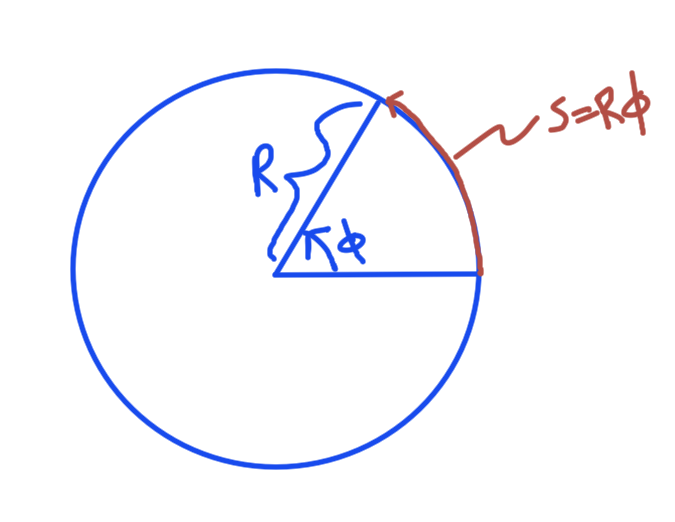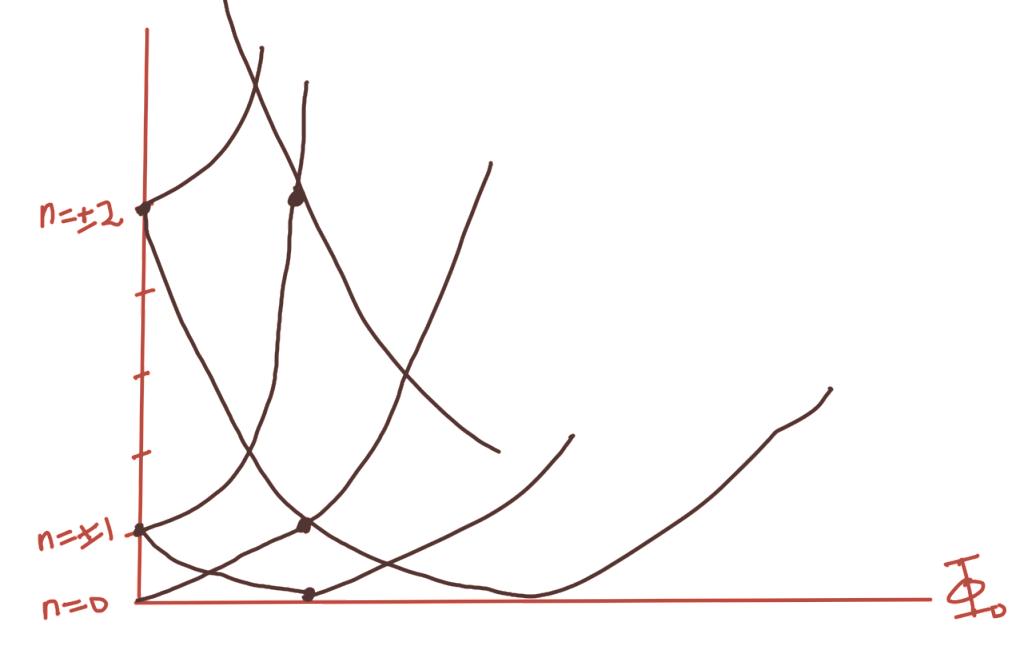[Click here for a PDF of this post with nicer formatting]
Disclaimer
Peeter’s lecture notes from class. These may be incoherent and rough.
These are notes for the UofT course PHY1520, Graduate Quantum Mechanics, taught by Prof. Paramekanti.
Schrodinger Derivation
Recall that a “derivation” of the Schrodinger equation can be associated with the following equivalences
\begin{equation}\label{eqn:qmLecture8:300}
E \leftrightarrow \Hbar \omega \leftrightarrow i \Hbar \PD{t}{}
\end{equation}
\begin{equation}\label{eqn:qmLecture8:320}
p \leftrightarrow \Hbar k \leftrightarrow -i \Hbar \PD{t}{}
\end{equation}
so that the classical energy relationship
\begin{equation}\label{eqn:qmLecture8:20}
E = \frac{p^2}{2m}
\end{equation}
takes the form
\begin{equation}\label{eqn:qmLecture8:40}
i \Hbar \PD{t}{} = -\frac{\Hbar^2}{2m}.
\end{equation}
How do we do this in a relativistic context where the energy momentum relationship is
\begin{equation}\label{eqn:qmLecture8:60}
E = \sqrt{ p^2 c^2 + m^2 c^4 } \approx m c^2 + \frac{p^2}{2m} + \cdots
\end{equation}
where \( m \) is the rest mass and \( c \) is the speed of light.
Attempt I
\begin{equation}\label{eqn:qmLecture8:80}
E = m c^2 + \frac{p^2}{2m} + (…) p^4 + (…) p^6 + \cdots
\end{equation}
First order in time, but infinite order in space \( \partial/\partial x \). Useless.
Attempt II
\begin{equation}\label{eqn:qmLecture8:100}
E^2 = p^2 c^2 + m^2 c^4.
\end{equation}
This gives
\begin{equation}\label{eqn:qmLecture8:120}
-\Hbar^2 \PDSq{t}{\psi} = – \Hbar^2 c^2 \PDSq{x}{\psi} + m^2 c^4 \psi.
\end{equation}
This is the Klein-Gordon equation, which is second order in time.
Attempt III
Suppose that we have the matrix
\begin{equation}\label{eqn:qmLecture8:140}
\begin{bmatrix}
p c & m c^2 \\
m c^2 & – p c
\end{bmatrix},
\end{equation}
or
\begin{equation}\label{eqn:qmLecture8:160}
\begin{bmatrix}
m c^2 & i p c \\
-i p c & – m c^2
\end{bmatrix},
\end{equation}
These both happen to have eigenvalues \( \lambda_{\pm} = \pm \sqrt{p^2 c^2} \). For those familiar with the Dirac matrices, this amounts to a choice for different representations of the gamma matrices.
Working with \ref{eqn:qmLecture8:140}, which has some nicer features than other possible representations, we seek a state
\begin{equation}\label{eqn:qmLecture8:180}
\Bpsi =
\begin{bmatrix}
\psi_1(x, t) \\
\psi_2(x, t) \\
\end{bmatrix},
\end{equation}
where we aim to write down an equation for this composite state.
\begin{equation}\label{eqn:qmLecture8:200}
i \Hbar \PD{t}{\Bpsi} = \BH \Bpsi
\end{equation}
Assuming the matrix is the Hamiltonian, multiplying that with the composite state gives
\begin{equation}\label{eqn:qmLecture8:220}
\begin{aligned}
\begin{bmatrix}
i \Hbar \PD{t}{\psi_1} \\
i \Hbar \PD{t}{\psi_1}
\end{bmatrix}
&=
\begin{bmatrix}
\hat{p} c & m c^2 \\
m c^2 & – \hat{p} c
\end{bmatrix}
\begin{bmatrix}
\psi_1(x, t) \\
\psi_2(x, t) \\
\end{bmatrix} \\
&=
\begin{bmatrix}
\hat{p} c \psi_1 + m c^2 \psi_2 \\
m c^2 \psi_1 – \hat{p} c \psi_2
\end{bmatrix}.
\end{aligned}
\end{equation}
What happens when we square this?
\begin{equation}\label{eqn:qmLecture8:240}
\begin{aligned}
\lr{ i \Hbar \PD{t}{} }^2 \Bpsi
&= \BH \BH \Bpsi \\
&=
\begin{bmatrix}
\hat{p} c & m c^2 \\
m c^2 & – \hat{p} c
\end{bmatrix}
\begin{bmatrix}
\hat{p} c & m c^2 \\
m c^2 & – \hat{p} c
\end{bmatrix}
\Bpsi \\
&=
\begin{bmatrix}
\hat{p}^2 c^2 + m^2 c^4 & 0 \\
0 & \hat{p}^2 c^2 + m^2 c^4 \\
\end{bmatrix}.
\end{aligned}
\end{equation}
That is
\begin{equation}\label{eqn:qmLecture8:260}
– \Hbar^2 \PDSq{t}{} \Bpsi
=
\lr{ \hat{p}^2 c^2 + m^2 c^4 } \mathbf{1} \Bpsi,
\end{equation}
or more exactly
\begin{equation}\label{eqn:qmLecture8:280}
– \Hbar^2 \PDSq{t}{} \psi_{1,2}
=
\lr{ \hat{p}^2 c^2 + m^2 c^4 } \psi_{1,2}.
\end{equation}
This recovers the Klein Gordon equation for each of the wave functions \( \psi_1, \psi_2 \).
Instead of squaring the operators, lets try to solve the first order equation. To do so we’ll want to diagonalize \( \BH \).
Before doing that, let’s write out the Hamiltonian in an alternate but useful form
\begin{equation}\label{eqn:qmLecture8:340}
\BH
=
\hat{p} c
\begin{bmatrix}
1 & 0 \\
0 & -1
\end{bmatrix}
+
m c^2
\begin{bmatrix}
0 & 1 \\
1 & 0
\end{bmatrix}
= \hat{p} c \hat{\sigma}_z + m c^2 \hat{\sigma}_x.
\end{equation}
We have two types of operators in the mix here. We have matrix operators that act on the wave function matrices, as well as derivative operators that act on the components of those matrices.
We have
\begin{equation}\label{eqn:qmLecture8:360}
\hat{\sigma}_z
\begin{bmatrix}
\psi_1 \\
\psi_2 \\
\end{bmatrix}
=
\begin{bmatrix}
\psi_1 \\
-\psi_2 \\
\end{bmatrix},
\end{equation}
and
\begin{equation}\label{eqn:qmLecture8:380}
\hat{\sigma}_x
\begin{bmatrix}
\psi_1 \\
\psi_2 \\
\end{bmatrix}
=
\begin{bmatrix}
\psi_2 \\
\psi_1 \\
\end{bmatrix}.
\end{equation}
Because the derivative actions of \( \hat{p} \) and the matrix operators are independent, we see that these operators commute. For example
\begin{equation}\label{eqn:qmLecture8:400}
\hat{\sigma}_z \hat{p}
\begin{bmatrix}
\psi_1 \\
\psi_2 \\
\end{bmatrix}
=
\hat{\sigma}_z
\begin{bmatrix}
-i \Hbar \PD{x}{\psi_1} \\
-i \Hbar \PD{x}{\psi_2} \\
\end{bmatrix}
=
\begin{bmatrix}
-i \Hbar \PD{x}{\psi_1} \\
i \Hbar \PD{x}{\psi_2} \\
\end{bmatrix}
=
\hat{p}
\hat{\sigma}_z
\begin{bmatrix}
\psi_1 \\
\psi_2 \\
\end{bmatrix}.
\end{equation}
Diagonalizing it
Suppose the wave function matrix has the structure
\begin{equation}\label{eqn:qmLecture8:420}
\Bpsi =
\begin{bmatrix}
f_{+} \\
f_{-} \\
\end{bmatrix}
e^{i k x}.
\end{equation}
We’ll plug this into the Schrodinger equation and see what we get.

